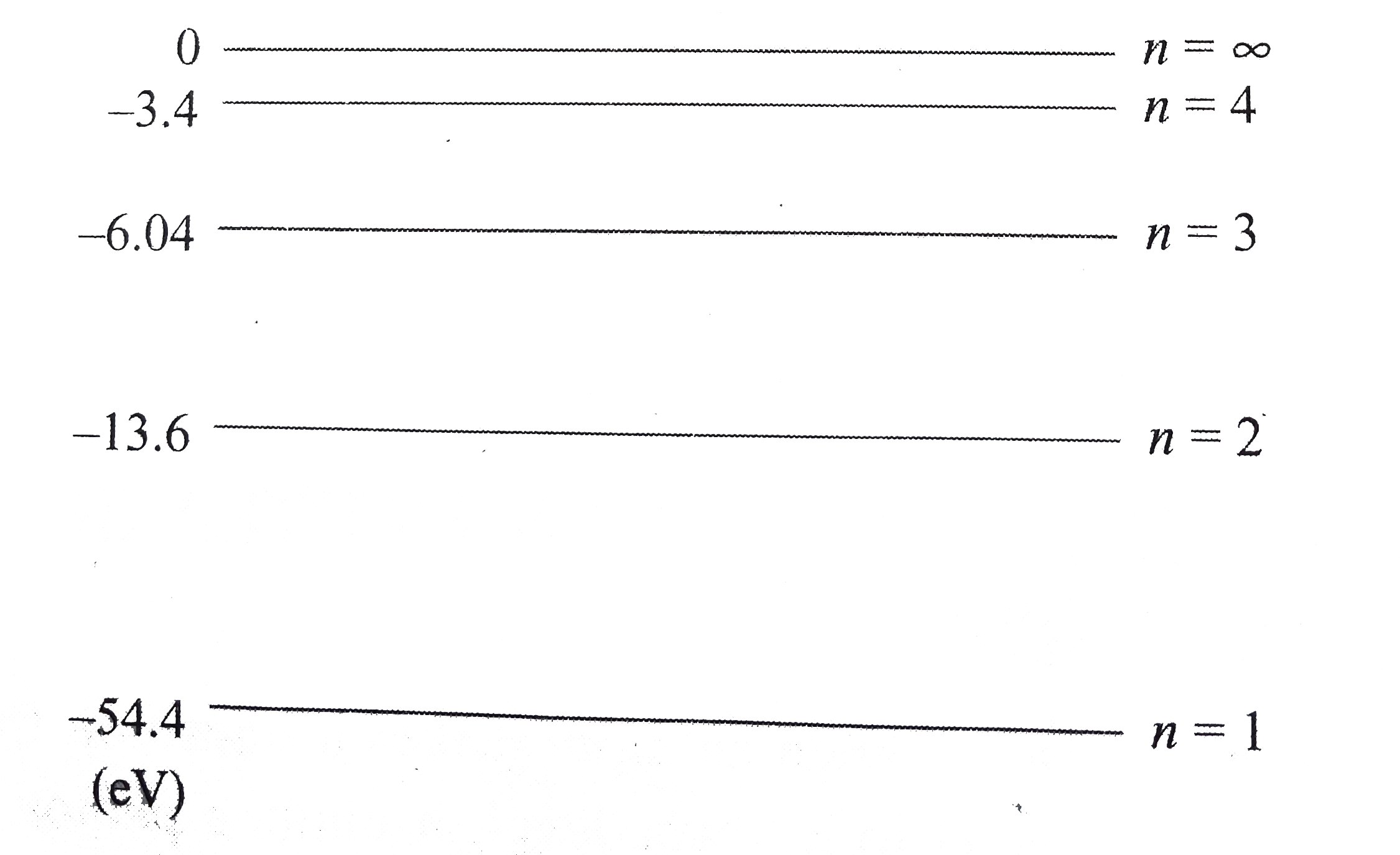A μon is an unstable elementary particle whose mass is 207me and whose charge is either+e or −e. A negative muon (μ−1) can be captured by a nucleus to form a muonic atom.
(a) A proton captures a μ−. Find the radius of the first Bohr orbit of this atom.
(b) Find the ionization energy of the atom.
Hence m=207meandM=1836me:so the reduced mass is
μ=Mmm+M=(207me)(1836me)207me+(1836me)=186me
According to equation λ=h/p , the orbid radius corresponding to n=1isr1=h2ε0πmee2=5.29×10−11m
Hence , the redius r' that corresponding to the reduced mass μ is
r'1=(mμ)r1=(me1836me)r1=2.85×10−13m
The muon is 186 times closer to the proton than an electron would be in the same orbit.
b. We have E1=(μm)e1=186×(−13.6)eV
⇒E1=−2.53×103eV=−2.53keV.
The ionization energy is , therefore , 2.53keV.186 times that for an ordinary hydrogen atom.
Topper's Solved these Questions
- BOOK - CENGAGE PHYSICS ENGLISHCHAPTER - ATOMIC PHYSICSEXERCISE - Solved Examples23videos
ATOMIC PHYSICS
- BOOK - CENGAGE PHYSICS ENGLISHCHAPTER - ATOMIC PHYSICSEXERCISE - Exercise 4.115videos
ATOMIC PHYSICS
- BOOK - CENGAGE PHYSICS ENGLISHCHAPTER - ALTERNATING CURRENTEXERCISE - Single Correct10videos
ALTERNATING CURRENT
- BOOK - CENGAGE PHYSICS ENGLISHCHAPTER - CAPACITOR AND CAPACITANCEEXERCISE - Integer5videos
CAPACITOR AND CAPACITANCE
Similar Questions
A muan is an unstable elementary partical whose mass (μ−) can be captured by a hydrogen nucleus (or proton) to from a muonic atom.
a Find the redius of the first Bohr orbit of this atom.
b Find the ionization energy of the atom.View SolutionA μ−meson("charge -e , mass = 207 m, where m is mass of electron") can be captured by a proton to form a hydrogen - like ''mesic'' atom. Calculate the radius of the first Bohr orbit , the binding energy and the wavelength of the line in the Lyman series for such an atom. The mass of the proton is 1836 times the mass of the electron. The radius of the first Bohr orbit and the binding energy of hydrogen are 0.529Å and 13.6eV , repectively. TakeR = 1.67 xx 109678 cm^(-1)
View SolutionFind radius
(A) 1st Bohr orbit of H-atom
(B) 2nd shell of Li+2 ion (Z=3)
(C ) M shell of He+ ion (Z=2)View SolutionThe muon has the same change as an electron but a mass that is 207 times greater. The negetively charged muon can bind to a prtoton to form a new type of hydrogen atom. How does the binding energy EBμ, of the muon the ground state of muonic hydrogen atom campare with the binding energy EBe' of an electron in the ground state of a conventional hydrogen atom?
View SolutionMu on (μ−) is a negatively charged (|q|=|e|) particle with a mas mμ=200me where me is the mass of the electron and e is the electronic charge . If μ− is bound to a proton to from a hgydrogen like atom identify the correct statements
(A) Radius of the muonic orbit is 200 times smaller than that of the electron
(B) The speed of the μ− in the nth orbit is 1200 times that of the electron in the nth orbit
(c )The ionizaion energy of muonic atom is 200 times more than that of an hydrogen atom
(D) The momentum of the muon in the mth orbit is 200 times more than that of the electronView SolutionA particle known as mu meson has a charge equal to that of no electron and mass 208times the mass of the electron B moves in a circular orbit around a nucleus of charge +3e Take the mass of the nucleus to be infinite Assuming that the bohr's model is applicable to this system (a)drive an expression for the radius of the nth Bohr orbit (b) find the value of a for which the radius of the orbit it appropriately the same as that at the first bohr for a hydrogen atom (c) find the wavelength of the radiation emitted when the u - mean jump from the orbit to the first orbit
View SolutionA doubly ionized lithium atom is hydrogen like with atomic
. number 3. Find the wavelength of the radiation to excite the electron in
. Li++ form the first to the third Bohr orbit. The ionization energy of the hydrogen
. Atom is 13.6V.View SolutionThe energy level excitation potential of a hydrogen -like atom is shown in Figure

a Find the value of Z
b If initially the atom is in the ground state ,then
(i) determine its excitation potential, and
m (ii) determine its ionization potential.
c Can it absorbe a photom of 42eV?
d Can it absorbe a photom of 56eV?
e Calculate the radius of its first Bohr orbit.
f Calculate the kinectic and potential energy of an electron in the first orbit.View SolutionA single electron orbit around a stationary nucleus of charge +Ze where Z is a constant and e is the magnitude of the electronic charge. It requires47.2eV to excite the electron from the second bohr orbit to the third bohr orbit. Find
(i) The value of Z
(ii) The energy required by nucleus to excite the electron from the third to the fourth bohr orbit
(iii) The wavelength of the electronmagnetic radiation required to remove the electron from the first bohr orbit to inlinity
(iv) The energy potential energy potential energy and the angular momentum of the electron in the first bohr orbit
(v) The radius of the first bohr orbit (The ionization energy of hydrogen atom =13.6eV bohr radius =5.3×10−11matre velocity of light =3×108m/sec planks 's constant =6.6×10−34 jules - sec )View SolutionAn imaginary particle has a charge equal to that of an electron and mass 100 times tha mass of the electron. It moves in a circular orbit around a nucleus of charge + 4 e. Take the mass of the nucleus to be infinite. Assuming that the Bhor model is applicable to this system. (a)Derive an experssion for the radius of nth Bhor orbit. (b) Find the wavelength of the radiation emitted when the particle jumps from fourth orbit to the second orbit.
View Solution

